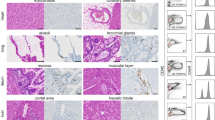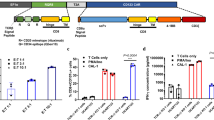Abstract
The cure of chronic myeloid leukemia (CML) patients following allogeneic stem cell transplantation (SCT) is attributed to graft-versus-leukemia (GVL) effects targeting alloantigens and/or leukemia-associated antigens (LAA) on leukemia cells. To assess the potential of LAA-peptide vaccines in eliminating leukemia in CML patients, we measured WT1, PR3, ELA2 and PRAME expression in CD34+ progenitor subpopulations in CML patients and compared them with minor histocompatibility antigens (mHAgs) HA1 and SMCY. All CD34+ subpopulations expressed similar levels of mHAgs irrespective of disease phase, suggesting that in the SCT setting, mHAgs are the best target for GVL. Furthermore, WT1 was consistently overexpressed in advanced phase (AdP) CML in all CD34+ subpopulations, and mature progenitors of chronic phase (CP) CML compared to healthy individuals. PRAME overexpression was limited to more mature AdP-CML progenitors only. Conversely, only CP-CML progenitors had PR3 overexpression, suggesting that PR1-peptide vaccines are only appropriate in CP-CML. Surface expression of WT1 protein in the most primitive hematopoietic stem cells in AdP-CML suggest that they could be targets for WT1 peptide-based vaccines, which in combination with PRAME, could additionally improve targeting differentiated progeny, and benefit patients responding suboptimally to tyrosine kinase inhibitors, or enhance GVL effects in SCT patients.
This is a preview of subscription content, access via your institution
Access options
Subscribe to this journal
Receive 12 print issues and online access
$259.00 per year
only $21.58 per issue
Buy this article
- Purchase on Springer Link
- Instant access to full article PDF
Prices may be subject to local taxes which are calculated during checkout




Similar content being viewed by others
References
Barrett J . Allogeneic stem cell transplantation for chronic myeloid leukemia. Semin Hematol 2003; 40: 59–71.
Kolb HJ, Schmid C, Barrett AJ, Schendel DJ . Graft-versus-leukemia reactions in allogeneic chimeras. Blood 2004; 103: 767–776.
Barrett AJ, Rezvani K . Translational mini-review series on vaccines: peptide vaccines for myeloid leukaemias. Clin Exp Immunol 2007; 148: 189–198.
Druker BJ, Guilhot F, O'Brien SG, Gathmann I, Kantarjian H, Gattermann N et al. Five-year follow-up of patients receiving imatinib for chronic myeloid leukemia. N Engl J Med 2006; 355: 2408–2417.
Hughes TP, Kaeda J, Branford S, Rudzki Z, Hochhaus A, Hensley ML et al. Frequency of major molecular responses to imatinib or interferon alfa plus cytarabine in newly diagnosed chronic myeloid leukemia. N Engl J Med 2003; 349: 1423–1432.
Bhatia R, Holtz M, Niu N, Gray R, Snyder DS, Sawyers CL et al. Persistence of malignant hematopoietic progenitors in chronic myelogenous leukemia patients in complete cytogenetic remission following imatinib mesylate treatment. Blood 2003; 101: 4701–4707.
Yong AS, Szydlo RM, Goldman JM, Apperley JF, Melo JV . Molecular profiling of CD34+ cells identifies low expression of CD7, along with high expression of proteinase 3 or elastase, as predictors of longer survival in patients with CML. Blood 2006; 107: 205–212.
Oka Y, Elisseeva OA, Tsuboi A, Ogawa H, Tamaki H, Li H et al. Human cytotoxic T-lymphocyte responses specific for peptides of the wild-type Wilms' tumor gene (WT1) product. Immunogenetics 2000; 51: 99–107.
Gao L, Bellantuono I, Elsasser A, Marley SB, Gordon MY, Goldman JM et al. Selective elimination of leukemic CD34(+) progenitor cells by cytotoxic T lymphocytes specific for WT1. Blood 2000; 95: 2198–2203.
Rezvani K, Brenchley JM, Price DA, Kilical Y, Gostick E, Sewell AK et al. T-cell responses directed against multiple HLA-A*0201-restricted epitopes derived from Wilms' tumor 1 protein in patients with leukemia and healthy donors: identification, quantification, and characterization. Clin Cancer Res 2005; 11 (24 Pt 1): 8799–8807.
Molldrem J, Dermime S, Parker K, Jiang YZ, Mavroudis D, Hensel N et al. Targeted T-cell therapy for human leukemia: cytotoxic T lymphocytes specific for a peptide derived from proteinase 3 preferentially lyse human myeloid leukemia cells. Blood 1996; 88: 2450–2457.
Fujiwara H, El Ouriaghli F, Grube M, Price DA, Rezvani K, Gostick E et al. Identification and in vitro expansion of CD4+ and CD8+ T cells specific for human neutrophil elastase. Blood 2004; 103: 3076–3083.
Griffioen M, Kessler JH, Borghi M, van Soest RA, van der Minne CE, Nouta J et al. Detection and functional analysis of CD8+ T cells specific for PRAME: a target for T-cell therapy. Clin Cancer Res 2006; 12: 3130–3136.
Greiner J, Schmitt M, Li L, Giannopoulos K, Bosch K, Schmitt A et al. Expression of tumor-associated antigens in acute myeloid leukemia: implications for specific immunotherapeutic approaches. Blood 2006; 108: 4109–4117.
Oka Y, Tsuboi A, Taguchi T, Osaki T, Kyo T, Nakajima H et al. Induction of WT1 (Wilms' tumor gene)-specific cytotoxic T lymphocytes by WT1 peptide vaccine and the resultant cancer regression. Proc Natl Acad Sci USA 2004; 101: 13885–13890.
Qazilbash MH, Wieder ED, Thall PF, Wang X, Rios R, Lu S et al. PR1 peptide vaccine-induced immune response is associated with better event-free survival in patients with myeloid leukemia. Blood 2007; 110: 90a; ref type: abstract.
Rezvani K, Yong AS, Mielke S, Savani BN, Musse L, Superata J et al. Leukemia-associated antigen-specific T-cell responses following combined PR1 and WT1 peptide vaccination in patients with myeloid malignancies. Blood 2008; 111: 236–242.
Jamieson CH, Ailles LE, Dylla SJ, Muijtjens M, Jones C, Zehnder JL et al. Granulocyte-macrophage progenitors as candidate leukemic stem cells in blast-crisis CML. N Engl J Med 2004; 351: 657–667.
Gabert J, Beillard E, van der Velden VH, Bi W, Grimwade D, Pallisgaard N et al. Standardization and quality control studies of ‘real-time’ quantitative reverse transcriptase polymerase chain reaction of fusion gene transcripts for residual disease detection in leukemia—a Europe Against Cancer program. Leukemia 2003; 17: 2318–2357.
Ogawa H, Tamaki H, Ikegame K, Soma T, Kawakami M, Tsuboi A et al. The usefulness of monitoring WT1 gene transcripts for the prediction and management of relapse following allogeneic stem cell transplantation in acute type leukemia. Blood 2003; 101: 1698–1704.
Rusakiewicz S, Molldrem JJ . Immunotherapeutic peptide vaccination with leukemia-associated antigens. Curr Opin Immunol 2006; 18: 599–604.
Radich JP, Dai H, Mao M, Oehler V, Schelter J, Druker B et al. Gene expression changes associated with progression and response in chronic myeloid leukemia. Proc Natl Acad Sci USA 2006; 103: 2794–2799.
Smit WM, Rijnbeek M, van Bergen CA, Fibbe WE, Willemze R, Falkenburg JH . T cells recognizing leukemic CD34(+) progenitor cells mediate the antileukemic effect of donor lymphocyte infusions for relapsed chronic myeloid leukemia after allogeneic stem cell transplantation. Proc Natl Acad Sci USA 1998; 95: 10152–10157.
Marijt WA, Heemskerk MH, Kloosterboer FM, Goulmy E, Kester MG, van der Hoorn MA et al. Hematopoiesis-restricted minor histocompatibility antigens HA-1- or HA-2-specific T cells can induce complete remissions of relapsed leukemia. Proc Natl Acad Sci USA 2003; 100: 2742–2747.
Molldrem JJ, Lee PP, Wang C, Felio K, Kantarjian HM, Champlin RE et al. Evidence that specific T lymphocytes may participate in the elimination of chronic myelogenous leukemia. Nat Med 2000; 6: 1018–1023.
Loren AW, Bunin GR, Boudreau C, Champlin RE, Cnaan A, Horowitz MM et al. Impact of donor and recipient sex and parity on outcomes of HLA-identical sibling allogeneic hematopoietic stem cell transplantation. Biol Blood Marrow Transplant 2006; 12: 758–769.
Randolph SS, Gooley TA, Warren EH, Appelbaum FR, Riddell SR . Female donors contribute to a selective graft-versus-leukemia effect in male recipients of HLA-matched, related hematopoietic stem cell transplants. Blood 2004; 103: 347–352.
Gratwohl A, Brand R, Apperley J, Biezen AA, Bandini G, Devergie A et al. Graft-versus-host disease and outcome in HLA-identical sibling transplantations for chronic myeloid leukemia. Blood 2002; 100: 3877–3886.
Yong AS, Rezvani K, Savani BN, Eniafe R, Mielke S, Goldman JM et al. High PR3 or ELA2 expression by CD34+ cells in advanced phase chronic myeloid leukemia is associated with improved outcome following allogeneic stem cell transplantation and may improve PR1 peptide driven graft-versus-leukemia effects. Blood 2007; 110: 770–775.
Normann AP, Egeland T, Madshus IH, Heim S, Tjonnfjord GE . CD7 expression by CD34+ cells in CML patients, of prognostic significance? Eur J Haematol 2003; 71: 266–275.
Martin-Henao GA, Quiroga R, Sureda A, Garcia J . CD7 expression on CD34+ cells from chronic myeloid leukaemia in chronic phase. Am J Hematol 1999; 61: 178–186.
Mohty M, Yong AS, Szydlo RM, Apperley JF, Goldman JM, Melo JV . Association between the polycomb group (PcG) BMI-1 gene expression and outcome in chronic myeloid leukemia (CML) patients receiving allogeneic stem cell transplantation (allo-SCT). Blood 2007; 110: 143a; ref type: abstract.
Molldrem JJ, Clave E, Jiang YZ, Mavroudis D, Raptis A, Hensel N et al. Cytotoxic T lymphocytes specific for a nonpolymorphic proteinase 3 peptide preferentially inhibit chronic myeloid leukemia colony-forming units. Blood 1997; 90: 2529–2534.
Acknowledgements
We thank Ms Loretta Pfannes for technical advice on the assessment of WT1 surface protein by flowcytometry. This research was supported by the Intramural Research Program of the National Heart, Lung and Blood Institute of the NIH.
Author information
Authors and Affiliations
Corresponding author
Additional information
Supplementary Information accompanies the paper on the Leukemia website (http://www.nature.com/leu)
Supplementary information
Rights and permissions
About this article
Cite this article
Yong, A., Keyvanfar, K., Eniafe, R. et al. Hematopoietic stem cells and progenitors of chronic myeloid leukemia express leukemia-associated antigens: implications for the graft-versus-leukemia effect and peptide vaccine-based immunotherapy. Leukemia 22, 1721–1727 (2008). https://doi.org/10.1038/leu.2008.161
Received:
Revised:
Accepted:
Published:
Issue Date:
DOI: https://doi.org/10.1038/leu.2008.161
Keywords
This article is cited by
-
Differences in PD-1 expression on CD8+ T-cells in chronic myeloid leukemia patients according to disease phase and TKI medication
Cancer Immunology, Immunotherapy (2020)
-
PR1 peptide vaccine induces specific immunity with clinical responses in myeloid malignancies
Leukemia (2017)
-
Clinical and biological predictors of outcome following relapse of CML post-allo-SCT
Bone Marrow Transplantation (2015)
-
Leukemia stem cells: the root of chronic myeloid leukemia
Protein & Cell (2015)
-
The role of peptide and DNA vaccines in myeloid leukemia immunotherapy
Cancer Cell International (2013)



